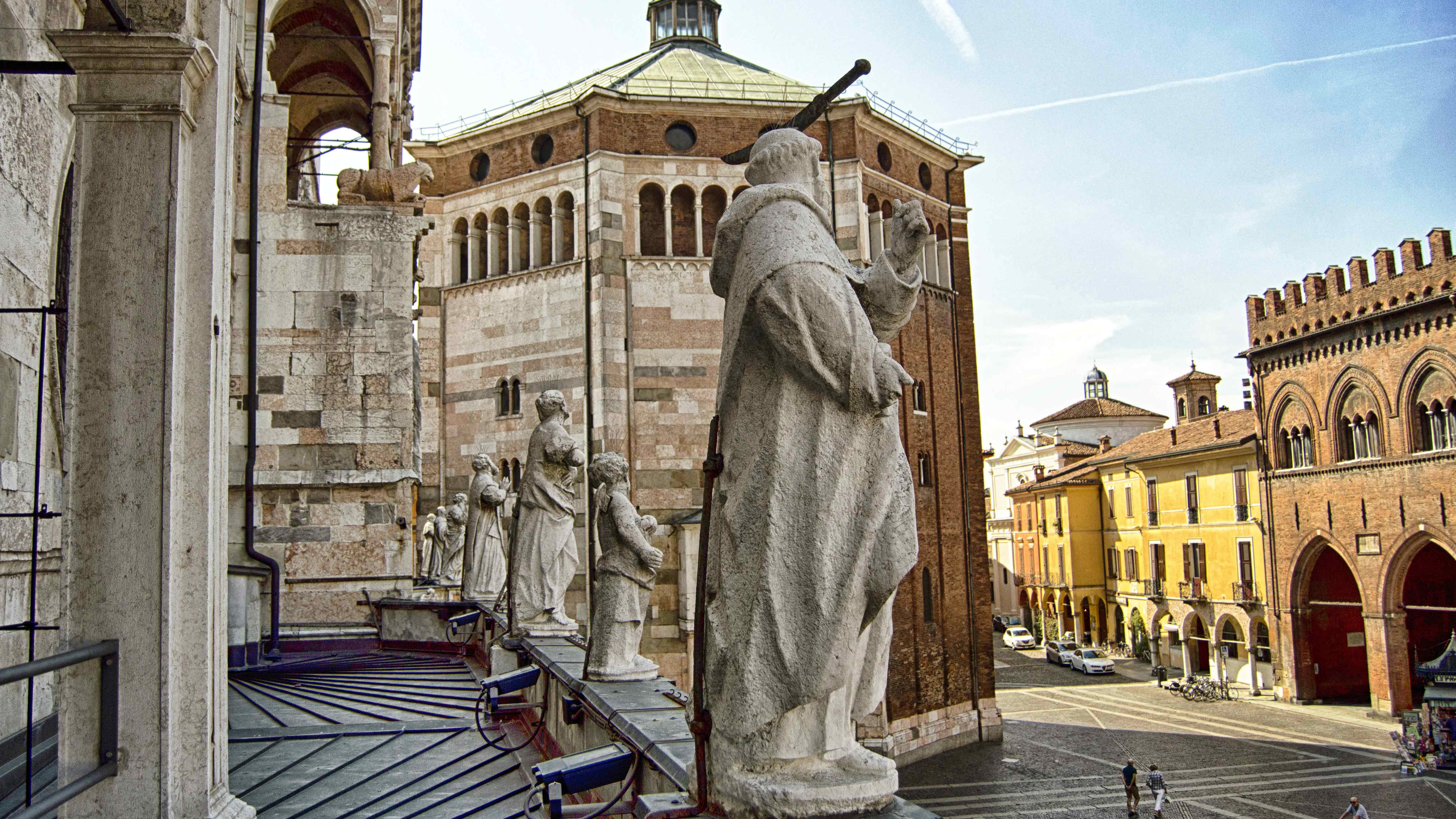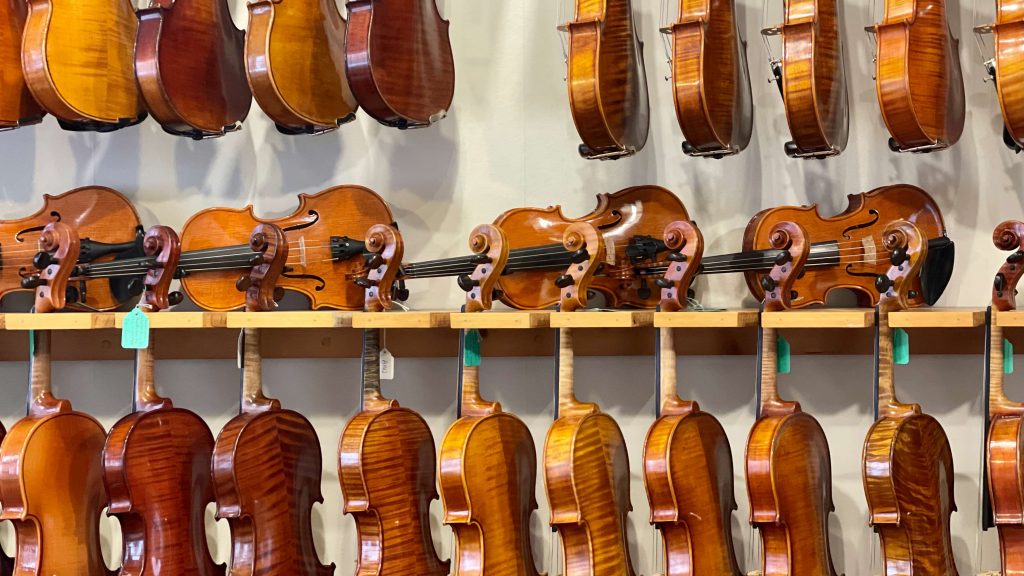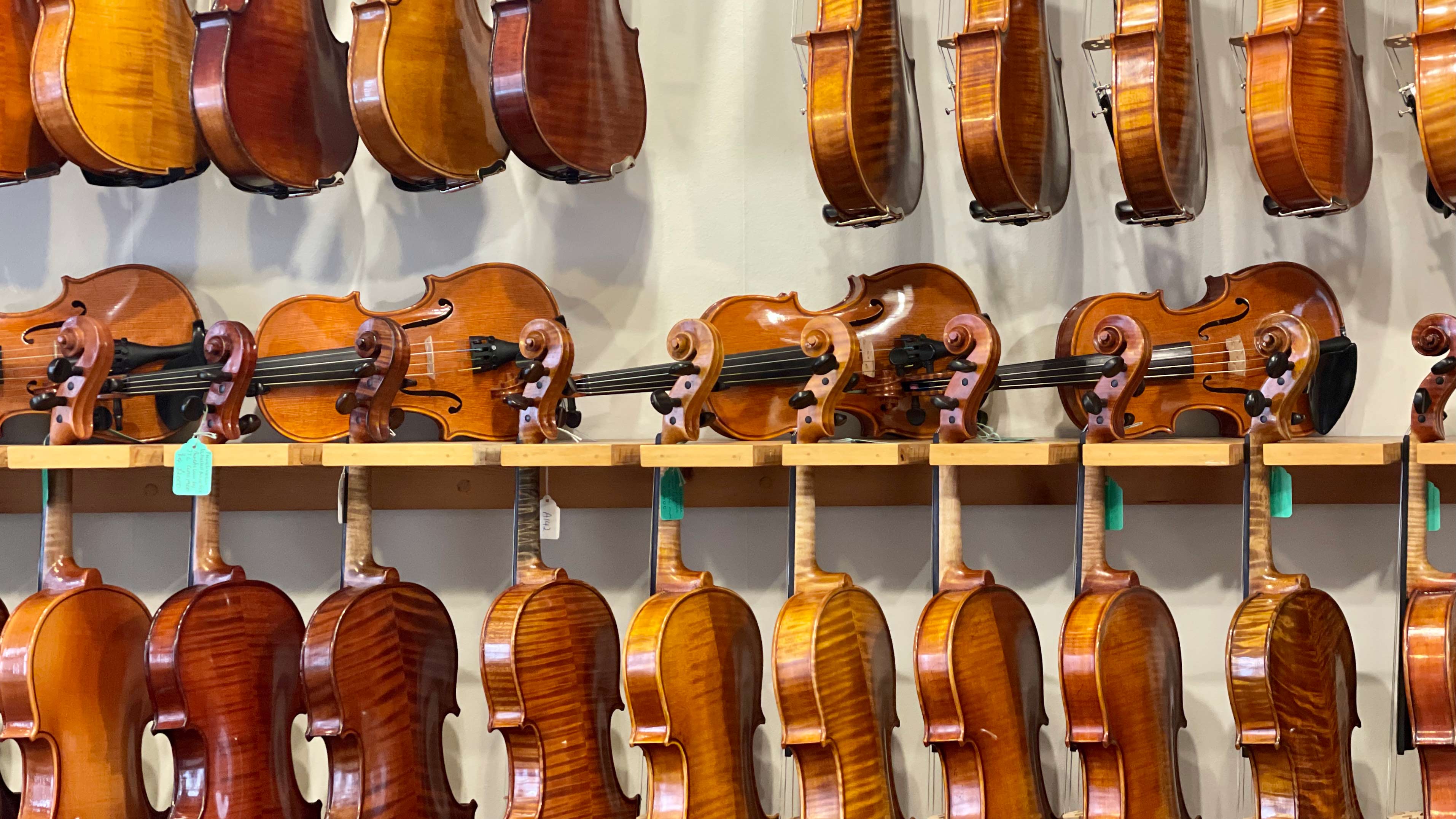Expert luthiers spend a few months making a single violin, but mass-produced violins from China are flooding the market, will they consider it as a threat?
In the midst of economic globalization, Cremona relies on the ancient craft of luthiery to support a lonely but not desolate literary economy. This small town of just over 200 square kilometres has not only produced masters such as Monteverdi, a representative of the Baroque music period, but also famous violin makers such as Stradivari and Jesu.
Visitors gather in a local violin-making workshop to listen to the luthier’s explanations and observe the production process, where the unique aroma of rosin fills the room with a sense of mystery. The workbench, full of wood chips, is organized with various tools. There are around 200 such workshops in Cremona.
Vittorio Villa is one of the luthiers who owns a violin workshop there,
“The job of making violins has chosen me! “he said, “I was a professional violinist before. Later I found that making violins allowed me to achieve my most gratifying results.”

No more than 15 violins can be made per year
On the edge of Stradivarius Square lies the local organization of luthiers. Although it has only existed for a decade, half of the 130 luthiers’ studios in Cremona are members of it.
This organization stipulates that its members must not make more than 15 instruments per year to guarantee quality. In addition, if a member is found to be passing off a factory instrument as a Cremona handmade instrument without permission, the association will immediately remove that person from its ranks.
Vittorio Villa makes between 10 and 15 violins a year, each of which takes about one month to make the wooden parts and another month to varnish them.
“Fortunately, the violin escapes from machinery production methods. Every piece of wood requires a different thickness and shape. Simplified pieces are not admitted,” said he.
To preserve local artisanal techniques, the association has established its brand, “Cremona luthier”, and has set strict rules for all aspects of production. For example, the wood must be chosen from traditional woods such as spruce, maple, and ebony; both production equipment and standard parts are used in the production process, and the violin must be made from various woods. There must be no element of industrial production.
Each “Cremona luthier” violin has an “identity card”, which includes personal information about the maker, a detailed description of the main parts of the instrument and a photograph. With this information, the buyer can check the “pedigree” of the violin in the association’s unique database.
These strict rules only guarantee that the instrument is not a fake and that the luthier’s passion for ensuring the instrument’s quality.
At the beginning of Vittorio’s career, he just tried to make a living with his work, and later, after finding his style and making many new-looking violins, he began to experiment with making replicas of ancient instruments. “Afterwards I discovered that my strong point was to “be myself” with my own style. My mature instruments are told to have a “soft antique looking”. It was a great satisfaction to him that musicians could recognize his violins from a distance.
“‘This is a Vittorio Villa violin!’ they started to say! From that point on my violins have had my own characteristics. Being able to play was a very very important help to refine “my” sound and also to make all the thousand details required by professional musicians in the best way,” said he.
To ensure that the violin reflects the buyer’s personality, the maker will have a lot of face-to-face meetings with the customer before selecting the materials and making the instrument.
The main customers are professional orchestra violinists and musicians. Apart from expensive handmade violins, factory instruments from China are a more affordable option for many beginners.
Not a threat, but a healthy competition
JP Guivier, violin dealer and restorer in London, the shop is hung with violins from all over the world, a large proportion of which come from China.

Richard, the shop’s director, has worked in the industry for over 30 years. He recalls that when he first started, these Chinese-made factory instruments were simple student outlets, accessible and not too expensive. Still, they needed some extra tweaking to make them easier to play.
“When we started dealing with instruments like that, we wanted to take that simple student outfit just on to the next level by doing a little bit of extra work to them, fitting the bridge properly, fitting the samples properly, just to make them a little bit easier to play,” said he.
About 25 years ago, in Richard’s experience, they began to discover quality instruments from Chinese factories. “I feel that that side of the Chinese making started to show become more attainable to the European and Western countries started a little bit later, when there were more highly trained Chinese makers, whether they went away to sort of train themselves or whether they had an impact from various European or Western violin making schools, “he said, “and since then, they just got better and better.”
Unlike many European-made violins, at first, there were no labels inside any of the violins made in China. Richard once spoke to the Chinese dealers and they usually refused to do so, though “nobody will want to buy it because it’s Chinese because Chinese reputation is for the sort of slightly simpler instruments, “he said, “I used to say them no, it’s really important to put your name in it, it helps your reputation and it helps your workshop business to become more and more established.”
At present, about six distributors are collaborating with JP Guivier, “they’re all very good. They’re just different. And there must be a little bit of competition between all of them, We can’t buy them all,” Richard said, “but in the end, it’s okay, that’s normal.”
Richards also mentioned that there are now many good young Chinese luthiers, “I think some really good makers now coming from China really highly trained. They’re the ones that will probably find it more difficult in the early days to compete with the European names. But as far as the sort of slightly better handmade instruments rather than the most expensive ones. Yeah, there’s a little bit of competition, but it’s okay. It keeps the standards improving all the time.”
The shop’s first floor places many factory instruments from all over the world, Romanian, German, English or Chinese, which is a good thing for the players. “So, they will have a variety to choose from, which is a good thing because it means that that person has a variety of instruments to choose from, with their playing qualities and sound. And they can just choose the one they like,” Richard said: “it’s good for us because we can give our customers a better selection. So yes, they’ve gone up in price a bit. But you know, they’re improving all the time. And we’re very happy to have them here”
For beginners, Richard considers Chinese student outfits are still the best, he said: “The Chinese workshops have been making beginner outfits for longer than anybody accessible outfits for longer than anybody. And although they’re very simple, they are still improving all the time. The student outfit, which is imported from China, when we first started selling 35 years ago, they’re good, they were good for 10 times better now.”
However, some Chinese factories on the market still still need to keep up with the times, making rather simple, cheap instruments and selling them on the internet at incredible prices. On amazon, there are even violin outlets that are selling them for less than £50.
Richard said: “Unfortunately, unsuspecting, people buy them from the internet because they look such good value. And then when they get them, they’re almost unplayable.”
This can often be encountered in the shop, Richard gave an example, there was a family who bought a cheap cello online but could not play it, the bridge was too low, and the sound post was in the wrong place. The shop offered a repair service, which was more expensive than the cello they bought online.
In addition to the proliferation of extremely low-priced violins on the internet, China’s current strict covid clearance policy has dealt a blow to the industry.
“Instruments from China are still getting here but they are taking longer, we just have to accept that we wait. And they are a little bit more expensive as well. So we were finding that when, when the better quality Chinese instruments started coming here, they were very, very good value,” Richard said: “With Brexit, and the pandemic, it has meant instruments from abroad, and particularly China, coming into this country has got a little bit more expensive again. But we’re finding they’re still good value.”
Richard also found that many people learned an instrument during the lockdown. Since they were able to restart the shop, they have come across a lot of customers who have started to practice the instrument they learned as a child. “We started seeing people bringing their instruments in and it also meant a lot of people started thinking about buying a new instrument as well. From that point of view, that’s good. And as a result, we’re beginning to get back to normal without ever being quite as normal as before. We’re getting busier.”
Europe luthiers don’t worry about the competition from China
China has gained a considerable reputation for producing low-cost instruments suitable for beginners. One of the critical areas in which the Chinese economy has achieved notable international triumphs is in the mass-produced violin industry.

Graham Vincent, a luthier in the UK, said “If you think of where is the centre of the violin nowadays, it’s in China,”
“I mean that a fantastic number of amazing players, a lot of amateur players as well, and some brilliant makers, and also factories making, cheaper violins as well. So I actually think we need to consider it as a real benefit to the violin, to be honest,” Graham said, “it’s keeping the world interested in the violin. It also supplies good quality violins to people who want to learn the violin. And more advanced players as well.”
Contemporary violin production centres in China have achieved a level of global influence that mirrors the factories of Germany and France nearly a century ago. This is a reminder that the competitive landscape is ever present and evolving. “In the past there, there have always been larger workshops, which churned out lots of violins, they used to be in Bohemia, they used to be in France, and they have always been competition,” said Graham.
Graham thinks his biggest competition isn’t Chinese violins, but antique violins, he said: “The sort of players that I’m trying to sell to are normally the sort of making the decision about whether they should buy a 150-year-old antique violin or whether they should buy a new violin. And if they decide to buy a new violin, they will generally be looking at a handmade violin from someone like me. So, I see my biggest competition as being people who restore antique violins and produce really nice, good quality antique violins.”
Many violins’ front body is made from spruce, but Graham has chosen unorthodox woods in his production, “I’m just making a violin with local apple wood, which no one makes instruments out of apple wood anymore, it’s gone completely fashion, but people will have seen that on Instagram, and they will be interested in it. So that gives mine a bit of uniqueness. And, so the person who might be interested in that might perceive that as a bit of character or a bit of soul,” said he.
With the trade of Chinese factory instruments in the European market, there was an Italian luthier comment that those instruments have no soul, and these large-scale manufacturing factories have had some influence on Cremona.
However, Vittorio Villa said it is fine for him. “Do they generally make violins to make business or to make something good? This is a question I often ask Italian violinmakers as well! Once again, factories are only looking for money, unlike single violinmakers”
“That’s a strong thing to say,” Richard thinks the trouble is, Cremona or Italy is the historical centre of violin making going back 400 years. So, it’s fair to say Italians will always think their violinmaking is the best.
“It’s so much bigger than that now, because good violin making really good violin making is all over the world, including China, and you cannot say that some of the very best makers who’ve gone through the same learning process and making experience, whether they be in Cremona, London, France, Beijing, it doesn’t mean to say that they don’t have soul,” Richard said, “there is no truth in that. It’s just an opinion, from a centre of violin making, which has a long history. It’s not a very nice thing to say.”
Yaksha Heifetz was one of the greatest violinists in the world. Someone once told him after a performance, “Your Guarneri sounds very nice this evening,” Heifetz held it up to his ear and said, “I hear nothing.” A great luthier and a great violinist are both necessary to give a great violin a soul, with playing the violin will be more than just artwork.

